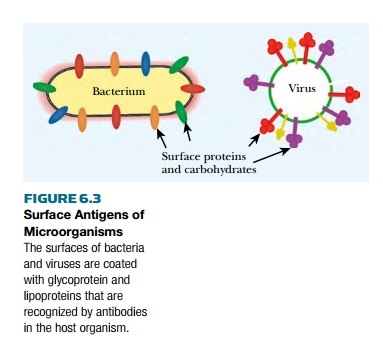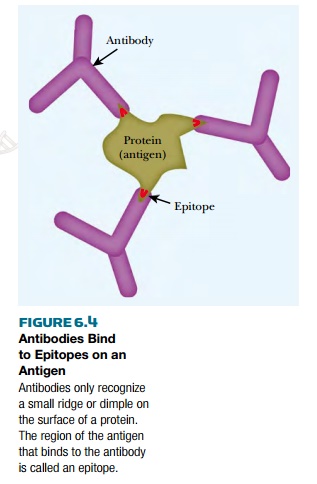Chapter: Biotechnology Applying the Genetic Revolution: Immune Technology
Antibodies, Antigens, and Epitopes
ANTIBODIES,
ANTIGENS, AND EPITOPES
The term antigen refers to any foreign molecule that provokes a response by the immune system. In practice, most antigens are proteins made by invading bacteria or viruses. In particular, glycoproteins, which carry carbohydrate residues, and lipoproteins, which carry lipid residues, generate strong immune responses, that is, they are highly antigenic. Other macromolecules can also work as antigens. Polysaccharides are often found as surface components of infiltrating germs and may act as antigens. Even DNA can be antigenic under certain circumstances.

Not surprisingly, the
antigens exposed on the surface of an alien microorganism will usually be
detected first by the immune system (Fig. 6.3). Later in infection, Virus
especially after the cells of some invaders have been disrupted by the immune
system, molecules from the interior of the infectious agent may be liberated
and also act as antigens.

The immune system mediates
immunity to various infectious agents through specific immunity or acquired
immunity. Acquired immunity can be
subdivided into humoral immunity and cell-mediated immunity. Humoral
immunity is mediated by antibodies,
or immunoglobulins, in the blood
plasma, which are produced by B cells. Cell-mediated immunity is mediated by
antigen-specific cells called T
lymphocytes, which are divided into TH or T helper cells, and TC
or T cytotoxic cells. Antibodies generally bind to whole proteins, whereas T
cell receptors bind to fragments of protein. When an antibody binds to a
protein, it recognizes a relatively small area on the surface of the protein,
such as dimples or projections sticking out from the surface. Such recognition
sites are known as epitopes (Fig.
6.4). Because intact proteins are large molecules, they may have several epitopes on their surfaces. Consequently, several
different antibodies may be able to bind the same protein, although not usually
simultaneously, because antibodies are themselves large molecules.
T cells work in the same
manner but recognize only antigens expressed on the surface of other body
cells, particularly macrophages, cells infected with a virus, or
antibody-making B cells, as opposed to the microorganism itself. T cells
recognize these other cells via cell surface receptor proteins called the class I and class II major histocompatibility complexes (class I and class II MHCs). Class I MHCs activate
TH cells, and class II
MHCs activate TC cells.
MHC receptors are encoded by a family of genes that are different for every
person. These may be used to distinguish people, and must be matched in organ
transplantation to prevent rejection. Another name for the MHC receptors are human leukocyte antigens (HLAs).
Related Topics